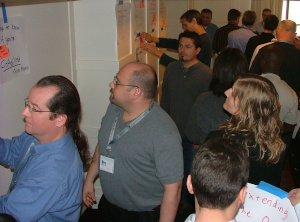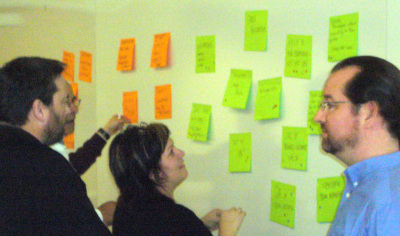 Want to know a secret to making decisions that will lead to better outcomes? Not so fast. Well actually, not too soon. The timing of when you make your decision will have a big impact on how well things work out.
Want to know a secret to making decisions that will lead to better outcomes? Not so fast. Well actually, not too soon. The timing of when you make your decision will have a big impact on how well things work out.
Our natural tendency is to decide too early. It gives us the illusion of certainty. The problem is that you don’t know what you don’t know. Early decisions are made with less information than those we make later. Of course, it is possible to wait too long. You want to make decisions at the last responsible moment. This is the point where the cost of delaying the decision rises to meet the benefit of waiting for more information.
Read the full article…

 Organizations that are scaling up with scrum often find that
Organizations that are scaling up with scrum often find that  Everyone is super busy, yet things take forever to get done. I encounter this at organizations that are scaling up with scrum. All too often, leaders want to jump to a solution, such as implementing a scaling framework. Sadly, implementing a ‘fix’ without a deep understanding of the causes of the problem will likely make things worse. Blindly implementing the framework will make people even busier and things will take even longer to get done.
Everyone is super busy, yet things take forever to get done. I encounter this at organizations that are scaling up with scrum. All too often, leaders want to jump to a solution, such as implementing a scaling framework. Sadly, implementing a ‘fix’ without a deep understanding of the causes of the problem will likely make things worse. Blindly implementing the framework will make people even busier and things will take even longer to get done.
 A great way to continue your agile learning journey is attending conferences. You’ll learn, build your professional network, and earn SEUs to renew your scrum certifications. To make the conference selection process easier, or harder, we’ve published
A great way to continue your agile learning journey is attending conferences. You’ll learn, build your professional network, and earn SEUs to renew your scrum certifications. To make the conference selection process easier, or harder, we’ve published  It was a bad day at Geekaplex. A star developer’s computer had crashed hard, taking a week’s worth of new source code with it. The big boss was furious! I spoke up, “We need source control and a backup system.” The big boss looked at me and said: “Get some people together and make it happen!” I called my first-ever meeting and invited all of engineering.
It was a bad day at Geekaplex. A star developer’s computer had crashed hard, taking a week’s worth of new source code with it. The big boss was furious! I spoke up, “We need source control and a backup system.” The big boss looked at me and said: “Get some people together and make it happen!” I called my first-ever meeting and invited all of engineering. Nominal Group Technique (NGT) is a facilitation tool that helps a group quickly build a comprehensive list of ideas, issues, options or solutions, and then select the best one(s). NGT works faster than traditional brainstorming, yet generates more complete and higher quality results. NGT prevents the quieter voices from being overwhelmed and allows each participant to contribute to their full potential.
Nominal Group Technique (NGT) is a facilitation tool that helps a group quickly build a comprehensive list of ideas, issues, options or solutions, and then select the best one(s). NGT works faster than traditional brainstorming, yet generates more complete and higher quality results. NGT prevents the quieter voices from being overwhelmed and allows each participant to contribute to their full potential.  A scrum team’s definition of done helps them continuously add value to the product and avoid backsliding or breaking things. When a product meets the definition of done, new value is available and the stakeholders can access the value whenever they choose. One way to think about the definition of done, is as a checklist that helps us guarantee the quality of the product.
A scrum team’s definition of done helps them continuously add value to the product and avoid backsliding or breaking things. When a product meets the definition of done, new value is available and the stakeholders can access the value whenever they choose. One way to think about the definition of done, is as a checklist that helps us guarantee the quality of the product.